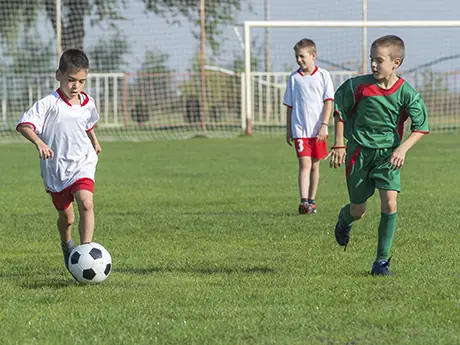
The ability of players to find good spaces on the field is key to effective attacking play. The more effective players are at finding space for themselves, the better they will be. Coaches play an important role in helping our players understand how to look for and create space. In this tutorial we will teach you the 5 key components of finding space, and then give you some tips and drills to use to teach this important skill to your players.
There are 5 keys to Finding Space on the soccer field
1. Recognizing Space.
Players must learn when, where and how to move off the ball. Encourage players to have their "head on swivel" and check what's around them as often as possible. The very best players in the world have great awareness of what surrounds them, and this gives them a 360-degree picture of where players are and most importantly where the space is.
2. Checking Runs.
Checking runs will maximize the space available when you receive through disguising your intention. Teach players to move away from space first and then check back to the space to receive the ball. Moving the defender away from where they want to be and then suddenly checking back quickly will lose the defender to create the space and time players needed to control the ball and make decisions. This movement is also great for getting in behind defenders, showing short and bringing them forwards before suddenly checking and running into the space in behind.
More: Coaching Tips: Principles of Attacking for Youth Soccer
3. Timing of movement.
The great Dutch player Johann Cryuff once said "I always look fast when I run first." Timing of movement is a key part of finding space to receive the ball. If a player is waiting in space before the ball is ready to be passed there, then the defender will be able to read the situation and adjust. Moving into space at the right time will maximize time and space by giving the defender less time to adjust to the situation. Players should read the game and wait until it is possible for the ball to be played before moving into the space to receive. It is a difficult skill to master but provides the foundation for all attacking and possession play.
4. Blind Spots.
Defenders are most comfortable when they can see both the ball and their man at the same time. When an attacker plays off the defender's shoulder and in their blind spot, placing the defender between themselves and the ball, it means the defender can't see the ball and the man at the same time. This slows down the defenders decision-making and gives the attacker the advantage.
5. Interchange and rotation:
Players should get in the habit of looking around them and having their movement on the field compliment the movement of their teammates. Advanced players and teams are constantly moving for each other, trying to unbalance opponents, pull defenders out of position, and create spaces for their teammates to exploit. Three of the most important relationships for interchanging positions are (1) between the center forwards and midfielders (2) between the wide forwards and wide defenders and (3) between the center forward and wide forwards.
More: Coaching Tips: Creating Space with the Soccer Ball
Learning to recognize and take up good spaces takes players a long time to learn, and coaches should be patient with their players as they learn this difficult part of the game. Encourage your players to take chances and reward them for good attempts at interchanging play.
How to coach players to find space:
1. Play lots of games in small, congested spaces, putting space at a premium.
2. Encourage players to check away and then toward the ball in all your passing exercises.
3. Encourage players to have their "head on a swivel"
4. Use overloaded attacking games such as "Drop the Goalie, "4 v 2 Transition Finishing" or rondos to encourage the recognition of space as well as encourage teammates to create space for each other.
5. Play numerous small sides games, from 2 versus 2 to 5 versus 5 and condition games so players must interchange positions.
 Find more soccer coaching tips.
Find more soccer coaching tips.
About the Author










Discuss This Article